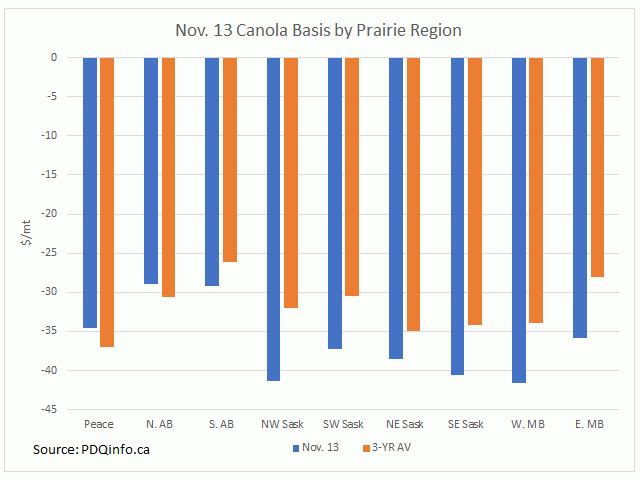Canada Markets
Canola Basis Bears Watching
There are several reasons to be bullish in the canola market. There is bullish news being released for the soybean crop, fresh contract highs reached for canola futures, an aggressive pace of canola demand and uncertainty surrounding the actual crop size. At the same time, canola basis has weakened modestly since the first trading day of November through to Nov. 13 in eight of nine regions of the Prairies monitored by pdqinfo.ca, while is weaker than the three-year average in seven of the nine regions for this date.
While Friday's cash close ranged from $518.96/metric ton to $531.52/mt across the nine regions, hitting $529.10/mt or $12 per bushel (bu) in two of the nine regions, it is the move in futures doing the heavy lifting, while basis seems far from reflecting concern.
As seen on the attached chart, the basis in the Peace region of northwest Alberta is $2.49/mt stronger than the three-year average as of Nov. 13, while the northern Alberta average basis is $1.61/mt stronger than average. The other seven regions range from $3.11/mt to $9.32/mt weaker than average, while averaging $6.38/mt weaker across the seven regions that are weaker than average.
P[L1] D[0x0] M[300x250] OOP[F] ADUNIT[] T[]
Flat prices generated by rising futures along with specials offered by grain companies have done their job to date. As of week 14, producers have delivered 6.4247 million metric tons, up 14.5% from the same period last crop year. While total disappearance is reported at 1.022 mmt or 10.7% higher than last year (exports plus domestic disappearance), commercial stocks of canola also remain high at 1.6495 mmt, 11.2% higher than the five-year average.
While it is possible to build a scenario that will lead to higher prices, a turn in South American weather that brings more widespread rainfall through Brazil and Argentina or a cancellation of Chinese soybean contracts with the U.S. could quickly lead to a sudden move lower. Here at home, Statistics Canada's Dec. 3 final production estimates may add clarity as the supplies available for the crop year.
It would be more comforting to see strengthening or narrowing basis while the futures are reaching fresh highs.
**
DTN 360 Poll
This week's poll asks if your grain marketing decision-making process has changed from past years? Have you priced more or less than normal for this time of year? You can share your thoughts on this poll which is found at the lower-right side of your DTN Home Page.
Cliff Jamieson can be reached at cliff.jamieson@dtn.com
Follow him on Twitter @Cliff Jamieson
(c) Copyright 2020 DTN, LLC. All rights reserved.





Comments
To comment, please Log In or Join our Community .